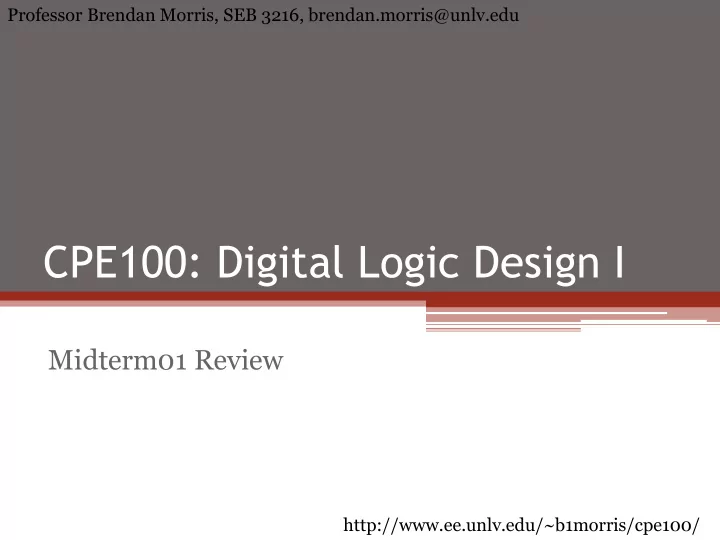

Professor Brendan Morris, SEB 3216, brendan.morris@unlv.edu CPE100: Digital Logic Design I Midterm01 Review http://www.ee.unlv.edu/~b1morris/cpe100/
2 Logistics • Thursday Oct. 3 th ▫ In normal lecture (13:00-14:15) ▫ 1 hour and 15 minutes • Chapters 1-2.6 • Closed book, closed notes • No calculators • Must show work and be legible for credit • Boolean Axioms and Theorems will be provided
3 Preparation • Read the book (2 nd Edition) ▫ Then, read it again • Do example problems ▫ Use both Harris and Roth books • Be sure you understand homework solutions • Come visit during office hours for questions
4 Chapter 1.2 Managing Complexity • Abstraction – hiding details that aren’t important • Digital discipline – restricting design choices to digital logic for more simple design • Hierarchy – dividing a system into modules and further submodules for easier understanding • Modularity – modules have well-defined functions and interfaces for easy interconnection • Regularity – uniformity among modules for reuse
5 Chapter 1.3 Digital Abstraction • Analog digital computing • Information in a discrete variable ▫ 𝐸 = log 2 𝑂 bits • Introduction to binary variables • Example1: Information in 9-state variable ▫ 𝐸 = log 2 9 = 3.1699 bits Note 3 bits can represent 8 values so requires just more than 3 bits
6 Chapter 1.4 – Number Systems • Number representation ▫ N-digit number {𝑏 𝑂−1 𝑏 𝑂−2 … 𝑏 1 𝑏 0 } of base 𝑆 in decimal 𝑏 𝑂−1 𝑆 𝑂−1 + 𝑏 𝑂−2 𝑆 𝑂−2 + ⋯ + 𝑏 1 𝑆 1 + 𝑏 0 𝑆 0 𝑂−1 𝑏 𝑗 𝑆 𝑗 = σ 𝑗=0 ▫ Range of values • Base 2, 10, 16, etc. conversion ▫ Often from base 𝑆 0 to decimal to 𝑆 1 ▫ Two methods: Repeatedly remove largest power of 2 Repeatedly divide by two
7 Number Examples • Convert 10110 2 to decimal • Convert 10110 2 to base 5 • Convert 10110 2 to hex and octal
8 Chapter 1.4.5 – Binary Addition • Signed number representation ▫ Unsigned, two’s complement, sign -magnitude • Addition ▫ Binary carries ▫ Potential for overflow • Subtraction ▫ Find negative of number and add • Zero/Sign extension
9 Example Binary Addition • Assume 6- bit 2’s complement • Add −25 10 + 18 10 and indicate if overflow occurs • Add 13 10 + 11 10 • Add 21 10 + 11 10 • Add −12 + 13
10 Chapter 1.5 – Logic Gates • NOT, BUF • XOR, NAND NOT BUF A Y A Y Y = A Y = A A Y A Y 0 1 0 0 1 0 1 1 • AND, OR • NOR, XNOR AND OR A A Y Y B B Y = AB Y = A + B A B Y A B Y 0 0 0 0 0 0 0 1 0 0 1 1 1 0 0 1 0 1 1 1 1 1 1 1
11 Example • Give truth table for logic gate
12 Chapter 1.6 Beneath Digital Abstraction • Noise margins Driver Receiver Output Characteristics Input Characteristics V DD Logic High Logic High Output Range Input Range V O H NM H V IH Forbidden Zone V IL V O L NM L Logic Low Logic Low Input Range Output Range GND NM H = V OH – V IH NM L = V IL – V OL
13 Example 1.18 • What is the inverter low and high noise margins • 𝑊 𝐸𝐸 = 5, 𝑊 𝐽𝑀 = 1.35, V IH = 3.15, V OL = 0.33, V OH = 3.84
14 Chapter 1.7 – Transistors • Voltage controlled switch • CMOS logic gates • NMOS – pass 0’s ▫ Connect to GND pMOS pull-up network inputs output nMOS • PMOS – pass 1’s pull-down ▫ Connect to VDD network
15 Example • Give the truth table and function
16 Chapter 1.7 – Power Consumption • Two types of power consumption • Dynamic – power required to charge gate capacitances (turn on/off transistor switches) 𝑒𝑧𝑜𝑏𝑛𝑗𝑑 = 1 2 𝑔 𝑄 2 𝐷𝑊 𝐸𝐸 • Static – power consumed when no gates switching 𝑄 𝑡𝑢𝑏𝑢𝑗𝑑 = 𝐽 𝐸𝐸 𝑊 𝐸𝐸
17 Chapter 2.2 – Boolean Equations • Terms: variable/complement, literal, product/implicant • Order of operations: NOT AND OR • Sum-of-product (SOP) form ▫ Determined by minterms of truth table • Product-of-sums (POS) form ▫ Determined by maxterms of truth table
18 Chapter 2.3 – Boolean Algebra • Boolean algebra is very much like our normal algebra • Need to know Boolean Axioms and Theorems ▫ Distributivity , covering, De Morgan’s • Proving equations ▫ Perfect induction/proof by exhaustion – show truth tables match ▫ Simplification – use theorems/axioms to show both sides of equation are equal
19 Chapter 2.3.5 – Simplifying Equations • Practice, practice, practice
20 Chapter 2.4 – Logic to Gates • Two-level schematic diagram of digital circuit Figure 2.23 Schematic of
21 Chapter 2.5 - Multilevel Combinational Logic • Convert gate level schematic into Boolean equation • Bubble pushing – application of De Morgan’s in schematic
22 Chapter 2.6 – Real Circuit Issues • Don’t cares: X ▫ Truth table flexibility • Contention: X A = 1 ▫ Illegal output value Y = X ▫ Output could be 1 or 0 B = 0 in error E • Floating: Z Y A ▫ High impedance, high Z ▫ Output between 0, 1 by E A Y 0 0 Z design 0 1 Z 1 0 0 1 1 1
Recommend
More recommend